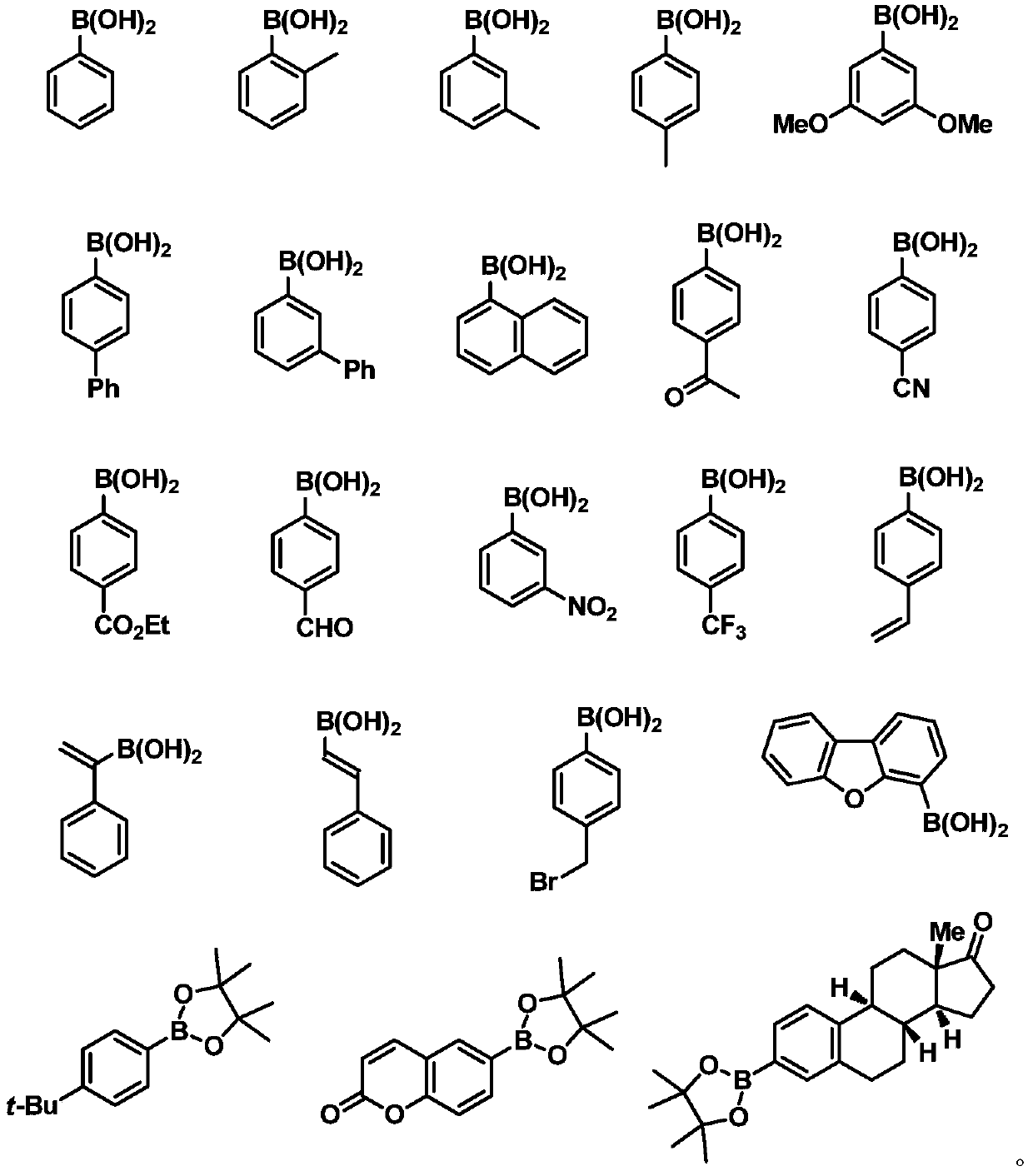Difluoropropargyl-containing compound, preparation method and application
A technology for difluoropropargyl compounds, applied in the preparation of organic compounds, steroids, organic silicon compounds, etc., can solve the problems of low reaction yield, lengthy reaction steps, poor regioselectivity, etc.
- Summary
- Abstract
- Description
- Claims
- Application Information
AI Technical Summary
Problems solved by technology
Method used
Image
Examples
Embodiment 1
[0072]
[0073] To a 25 mL reaction tube, add 0.72 mmol phenylboronic acid, 2.8 mg (0.5 mol%) tris(dibenzylideneacetone) dipalladium, 5.6 mg (3 mol%) tris(o-methylphenyl)phosphine, potassium carbonate ( 1.8 mmol), inject 136 mg (0.6 mmol) of 1-triisopropylsilyl-3-bromo-3,3-difluoropropyne, 1,4-dioxane (3.0 mL). After stirring at 80°C for 24 hours, the yield was 91%, and the purity was greater than 98% as identified by hydrogen spectrum. 1 H NMR (400MHz, CDCl 3 )7.72-7.70(m,2H),7.45-7.41(m,3H),1.15-1.10(m,21H). 19 F NMR (376MHz, CDCl 3 )-74.3(s,2F). 13 C NMR (126MHz, CDCl 3 )136.2(t, J=27.9Hz), 130.6(t, J=1.9Hz), 128.4, 125.4(t, J=4.5Hz), 111.6(t, J=231.0Hz), 98.9(t, J=39.9 Hz), 92.5(t, J=4.9Hz), 18.5, 11.0.IR (thin film method) ν max 3440,2945,2868,2186,1742cm -1 .MS(EI):m / z(%)308(M+),265,115(100).HRMSCalculated for(theoretical value):308.1772; Found(measured value):308.1771.
Embodiment 2
[0075]
[0076] To a 25 mL reaction tube, add 0.72 mmol 2-methylphenylboronic acid, 2.8 mg (0.5 mol%) tris(dibenzylideneacetone) dipalladium, 5.6 mg (3 mol%) tris(o-methylphenyl)phosphine, Potassium carbonate (1.8 mmol), injection of 136 mg (0.6 mmol) 1-triisopropylsilyl-3-bromo-3,3-difluoropropyne, 1,4-dioxane (3.0 mL). After stirring at 80°C for 24 hours, the yield was 77%, and the purity was greater than 98% as identified by hydrogen spectrum. 1 H NMR (400MHz, CDCl 3 )δ7.68(d, J=7.9Hz, 1H), 7.34(t, J=7.5Hz, 1H), 7.28-7.20(m, 2H), 2.56(s, 3H), 1.16–1.05(m, 21H ). 19 FNMR (376MHz, CDCl 3 )δ-77.0(s,2F). 13 C NMR (126MHz, CDCl 3 )δ136.5(t, J=2.1Hz), 134.1(t, J=26.2Hz), 131.8, 130.4(t, J=1.5Hz), 125.63(t, J=7.4Hz), 125.57, 111.8(t , J=232.9Hz), 99.2(t, J=40.3Hz), 91.9(t, J=5.0Hz), 19.8, 18.5, 11.0.IR (thin film method) ν max 3416,2946,2868,2184,1463cm -1 .MS(EI):m / z(%)323(M + +H + ),322(M + ), 279.129(100).HRMS: Calculated (theoretical value): 322.1928; Found (meas...
Embodiment 3
[0078]
[0079] Into a 25 mL reaction tube, add 0.72 mmol 3-methylphenylboronic acid, 2.8 mg (0.5 mol%) tris(dibenzylideneacetone) dipalladium, 5.6 mg (3 mol%) tris(o-methylphenyl)phosphine, Potassium carbonate (1.8 mmol), injection of 136 mg (0.6 mmol) 1-triisopropylsilyl-3-bromo-3,3-difluoropropyne, 1,4-dioxane (3.0 mL). After stirring at 80°C for 24 hours, the yield was 85%, and the purity was greater than 98% as identified by hydrogen spectrum. 1 H NMR (400MHz, CDCl 3 )δ7.56–7.48(m,2H),7.32(t,J=7.6Hz,1H),7.28–7.26(m,1H),2.39(s,3H),1.14–1.08(m,21H). 19 F NMR (376MHz, CDCl 3 )δ-74.3(s,2F). 13 C NMR (126MHz, CDCl3) δ138.3, 136.1(t, J=27.6Hz), 131.4(t, J=1.8Hz), 128.3, 126.1(t, J=4.4Hz), 122.5(t, J=4.5Hz) ,111.7(t,J=230.9Hz),99.0(t,J=39.9Hz),92.3(t,J=5.0Hz),21.4,18.5,11.0.IR(thin film method)ν max 3387,2946,2868,2359,2182,1277cm -1 .MS(EI):m / z(%)322(M + ),279,129(100).HRMS: Calculated (theoretical value): 322.1928; Found (measured value): 322.1925.
PUM
 Login to View More
Login to View More Abstract
Description
Claims
Application Information
 Login to View More
Login to View More - R&D
- Intellectual Property
- Life Sciences
- Materials
- Tech Scout
- Unparalleled Data Quality
- Higher Quality Content
- 60% Fewer Hallucinations
Browse by: Latest US Patents, China's latest patents, Technical Efficacy Thesaurus, Application Domain, Technology Topic, Popular Technical Reports.
© 2025 PatSnap. All rights reserved.Legal|Privacy policy|Modern Slavery Act Transparency Statement|Sitemap|About US| Contact US: help@patsnap.com



